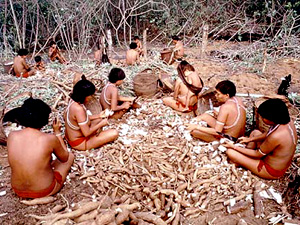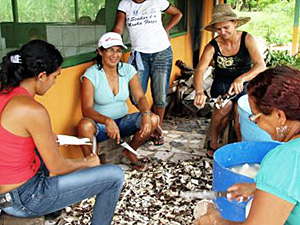- Top 10 Brazilian beachesPosted 11 years ago
- Top 10 female celebritiesPosted 11 years ago
- Top 10 Brazilian cocktailsPosted 11 years ago
- Top 10 Brazilian snacks: SalgadinhosPosted 11 years ago
- Top 20 Brazilian cigarsPosted 11 years ago
- Top 10 best snorkeling locations in BrazilPosted 11 years ago
- Brazil’s best coffee: Bourbon SantosPosted 11 years ago
Mandioca flour replaced wheat flour in Brazil
Mandioca Frita is Brazil’s answer to French fries. The tuber, also known as cassava root, was the main staple of the Brazilian natives at the time of discovery and has become an important food in all of Brazil. It is presented in several versions: as paçoca, carimã, mingau, beiju, farinha de mandioca and tucupi.
 History
History
The coastal Tupi Indians were the first aboriginal people to interact with the Portuguese, and in general, these contacts were peaceful. For years, settlers came to Brazil without their women – wives, if they were married, or female relatives. They soon found that the native women were far from reluctant to assume the white women’s role in bed as well as in the kitchen. As a result, Brazilian cookery developed with a solid native core – the heritage of these first Brazilian cooks and mothers of the first Brazilians born in the New World.
Since the humid, tropical environment was unsuitable for wheat and several other crops the Portuguese men were accustomed to eating, they were forced to develop many new eating habits based on indigenous foods. Of the many foods introduced by the native cooks, the manioc tuber, or cassava root, was a profound dietary change for these colonists. It was the main staple of the natives, a carbohydrate-rich food that is easy to propagate but difficult to process, at least for the bitter variety, which is poisonous when raw.
 Process
Process
It is astonishing that the Indians determined that these tubers were edible at all. To detoxify manioc, the tubers had to be peeled and grated and the pulp put into long, supple cylinders – called tipitis – made of woven plant fibers. Each tube was then hung with a heavy weight at the bottom, which compressed the pulp and expressed the poisonous juice. The pulp could then be removed, washed and roasted, rendering it safe to eat. The product was a toasted, coarse meal or flour known as farinha de mandioca, which is as basic to the diet of Brazilians today as it was to the early Indians.
Starch settling out from the extracted juice was heated on a flat surface, causing individual starch grains to pop open and clump together into small, round granules called tapioca. The extracted juice, boiled down to remove the poison, was used as the basis of the sauce known as tucupi. In the northern region of modern Brazil, several noted and delicious dishes incorporate this traditional sauce.
 Result
Result
Manioc meal became many things in the hands of the Indian women. Pulverized meal was mixed with ground fish to produce a concoction called paçoca. For the children, small, sun-dried cakes called carimã were prepared. There was a porridge or paste known as mingau, and thin, crisp snacks called beijus, made of either tapioca flour or dough from a non-poisonous, or sweet variety of manioc known as macaxeira or aipim. These sweet manioc tubers, which are somewhat fibrous but considerably easier to prepare, were also pared, boiled for several hours to soften them and eaten like potatoes.
The popularity today of a snack of fried, sweet manioc strips, Brazil’s answer to French fries, further attests to the important contribution of this foodstuff to Brazilian cuisine by the Indians.
Corn was another Indian staple that the colonists used as a substitute for wheat. Learning from the Indians, the Portuguese made corn porridges called acanijic, which can be found today as canjica or mugunzá, and used corn husks as containers to steam a sweet mixture of corn and coconut called pamuna, which came to be known as pamonha.
The continuing preference for manioc and corn flours over wheat is apparent in many areas of Brazil today. A great variety of these flours is available, including the fine, sweet or sour types, called polvilhos, made from tapioca starch. Cheese rolls called pão de queijo made from polvilho flour and eaten while still warm are incomparable.
